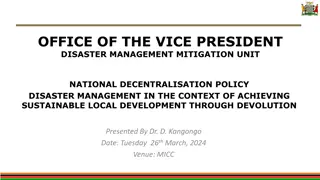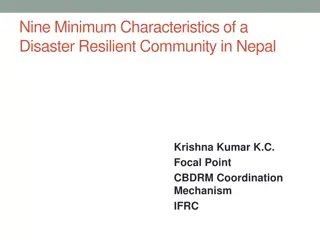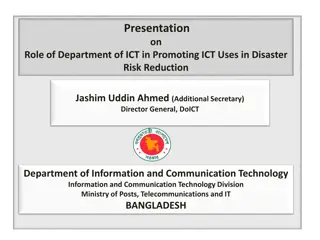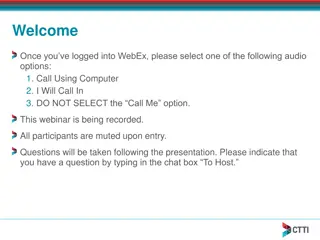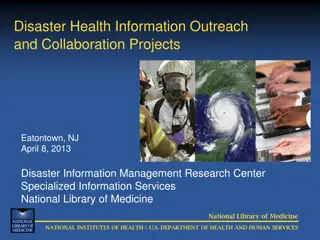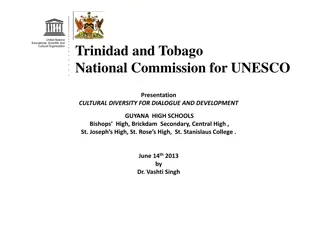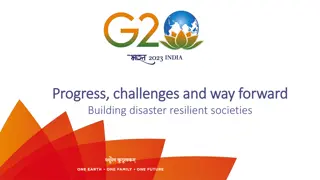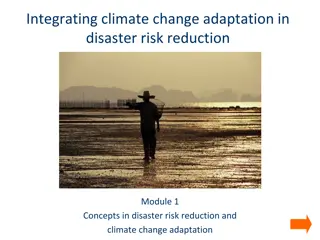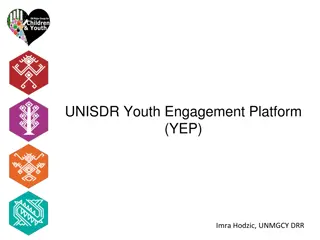Integrating Disaster Risk Reduction into ICH Inventorying for UNESCO
Learn how to apply a community-based approach to inventorying and safeguarding intangible cultural heritage within the context of disasters. This presentation offers frameworks, tools, and exercises to integrate disaster awareness into ICH inventorying and safeguarding practices, emphasizing the importance of involving communities, states parties, national agencies, and disaster relief managers. Key lessons focus on the dual nature of ICH in disaster contexts, the importance of assessing vulnerability, and the necessity of planning and resourcing with input from all relevant actors. The framework of People, Place, Story aids in identifying ICH in disasters by understanding the connections between living communities, their physical environments, and local knowledge, thereby facilitating the articulation, transmission, and safeguarding of ICH.
Download Presentation

Please find below an Image/Link to download the presentation.
The content on the website is provided AS IS for your information and personal use only. It may not be sold, licensed, or shared on other websites without obtaining consent from the author. Download presentation by click this link. If you encounter any issues during the download, it is possible that the publisher has removed the file from their server.
E N D
Presentation Transcript
Integrating Disaster Risk Reduction into ICH Inventorying U064 PowerPoint presentation UNESCO Intangible Cultural Heritage Section
In this presentation Goal: Learn how to apply a community-based approach to the inventorying and safeguarding of intangible cultural heritage in the context of disasters. Building on the knowledge acquired in Unit 63, this unit provides frameworks, tools and exercises to integrate disaster awareness into the inventorying and safeguarding of ICH. Coverage: Brief recap of previous Workshop (Unit 063) Identifying ICH in Disasters case study of ICH and disaster, and a framework for analysis Exercises integrating disaster awareness in community-based inventorying, and inventorying ICH for Disaster Risk Reduction Preparation for Group Exercise Cultural permissions and FPIC 2
Key Lessons of the Operational Principles and Modalities 1. ICH, in a disaster context: has a dual nature (vulnerability and risk reduction) requires an assessment of vulnerability, and emergency safeguarding measures, plans and funding can be deployed in all phases to mitigate the impacts of disaster 2. Actors, who need to be involved and in communication with each other, must include: communities (central to the identification and safeguarding of ICH) states parties and national agencies disaster relief and risk reduction managers 3. Planning and assessment, in all phases, must involve: input from and adequate resourcing of all actors, especially communities consideration, integration and incorporation of ICH safeguarding and mitigation at all levels from local to national (including PDNAs) sharing of information and results across all levels 3
Identifying ICH in Disasters: People, Place, Story a framework for analysis People, Place, Story is a model that helps us to understand the connections between a living community, its physical environment, and its local knowledge. Distinguishing between the human, tangible and intangible aspects of all ICH allows us to better understand how ICH is transmitted, where it is vulnerable, and thus the challenges and requirements of safeguarding. People are the human agents of ICH (individuals, communities, bearers, ancestors) Place is the tangible, material world (landscapes, buildings, artefacts, resources) Story represents the immaterial or the intangible (knowledge, narrative, tradition, language). 4
Identifying ICH in Disasters: Articulation, Transmission and Safeguarding The three different Modalities (People, Place, and Story) come together in the Articulation of actual, dynamic acts of performance, practice or production of ICH. Transmission is the communication of that ICH (as knowledge and practice) across both space and time. Safeguarding refers to the full suite of strategies (from local through to international) that understand and aim to support and enhance the viability of each of the different components of the People, Place and Story framework. 5
Identifying ICH in Disasters: the People, Place, Story Framework Handout 1: People, Place, Story: a Framework for ICH Transmission and Safeguarding Modality Form Articulation Transmission Safeguarding Individuals, communities, agents, transmitters, transactors, institutions, states Performance, expression, language, practice, mobilisation, production Space: Intra- group, external, exchange, trade, theft, conquest Local, national, regional and international strategies to enhance the viability of the forms, articulation and transmission of ICH People Time: Inter- generational, monumental, archival Material or tangible settings, sites, environments, resources, settlements, objects, artefacts Place Immaterial or intangible, knowledge, narrative, tradition Story 6
Identifying ICH in Disasters: Introducing the Case Studies Through two Case Studies, we will explore and identify examples of: a) b) the impact of disasters on ICH, and the role of ICH in reducing or mitigating risk in disaster contexts. The Case Studies include: Case Study 1: Cyclones and ICH in Northern Vanuatu Case Study 2: Mount Merapi, Indonesia: living on a volcano 7
Exercise 1: Impact of disaster on ICH Learning objective: Apply a preliminary disaster risk analysis to the ICH element that your group selected in the previous Unit / Workshop Method: Use the People, Place and Story framework to think about different kinds of ICH vulnerability, and exposure to different kinds of disaster How has the viability of your ICH element been impacted over a long period by one or more disasters or other emergencies? Record your example on Handout 2. 8
Handout 2: ICH Impacted by Disaster Exercise 1 ICH Impacted by Disaster Name of element disaster or emergency have impacted on this ICH element over time? What kinds of Which aspects of the element have been threatened or impacted? People? Place / Tangible resources? Story / Intangible resources? Practice? Transmission? 9
Exercise 2: Group Research on ICH Disaster Risk goal and objectives Goal: To complete the ICH Disaster Risk assessment for a selected ICH element This can be started during the workshop, or tackled later Learning objective: This exercise enables participants to consider: a) the impact of one or more hazards and emergencies on the safeguarding or ongoing practice of one or more ICH elements b) how the ICH might be mobilised during and after the hazard to mitigate the impact of disaster c) how the ICH might be transformed by the disaster or adapted by its bearers d) what measures need to be put in place to safeguard ICH and strengthen its transmission following disaster 10
Exercise 2: Group Research on ICH Disaster Risk steps Steps: Each group uses the same ICH element considered in last week s workshop and today s Exercise 1 - or chooses a new one (or several!) Confirm cultural permission or FPIC requirements associated with the selected ICH element(s) Each group meets to complete the remaining steps, doing further research as necessary Complete any gaps in Handout 1 from Unit 063, and in Handout 2 from this module Respond to the questions and prompts in Handout 3 Present the full results for discussion 11
EXERCISE 2a: ICH Risk in each phase of the Disaster Management Cycle This exercise allows your group to further develop Section 3 of the Sample Inventorying Framework State of the ICH element: viability (Handout 1 from Workshop 1) Phase: Threats to continued enactment Response Recovery Preparedness Threats to continued transmission Threats to access to resources Viability of other ICH Safeguarding or other measures in place Safeguarding or other measures required 12
Exercise 2b: Role of ICH in Mitigating or Reducing Disaster Risk Record any examples of a role for your ICH element (or any other related ICH) in any of the three phases of the disaster cycle: 1) ICH that is used to prepare for disaster 2) ICH that is used in the response phase of a disaster 3) ICH that is used to recover from disaster Preparedness Response Recovery Name of element 13
A self-test Test yourself now or later! What is the distinction between a natural hazard and a disaster? What are some of the reasons why impacts to ICH have been difficult to capture in Post Disaster Needs Assessments? What is the difference in emphasis between DRM and DRR? What are the different phases of the disaster cycle, and why are they different? How do the Operational Principles inform practical measures in each phase of the disaster cycle? Is there emergency financial or technical support available to support ICH safeguarding? How are the different modalities of ICH transmission and safeguarding brought together and articulated? Can you think of any critical issues for ICH inventorying and safeguarding in the context of disasters that have not been addressed in Units 63 and 64? 14
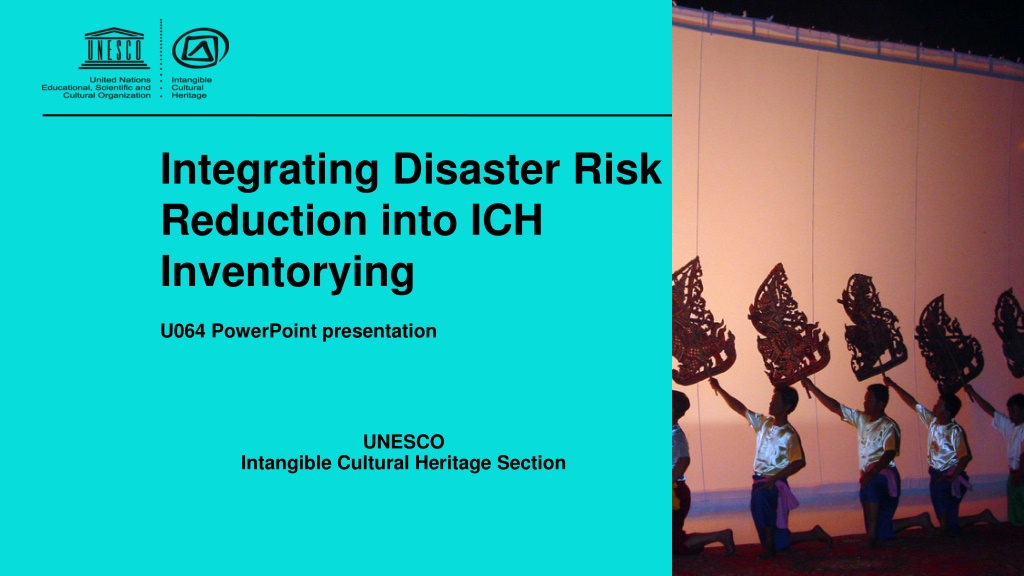
 undefined
undefined










